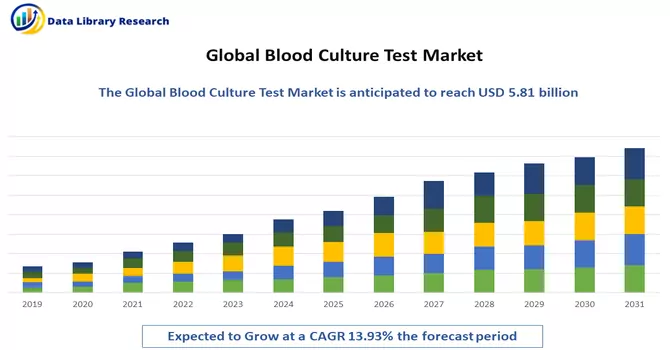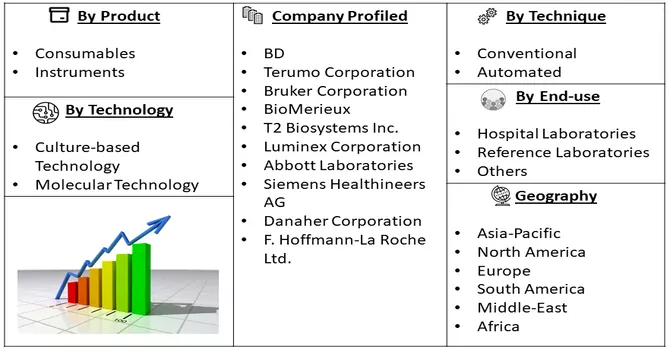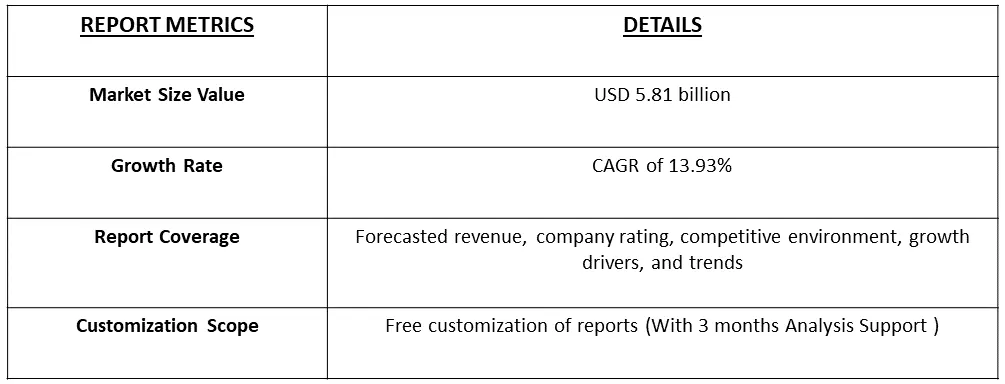The global blood culture test market size was estimated at USD 5.81 billion in 2023 and is expected to grow at a compound annual growth rate (CAGR) of 13.93% from 2024 to 2031.

Get Complete Analysis Of The Report - Download Free Sample PDF
A blood cell culture test is a diagnostic laboratory procedure that involves the cultivation and growth of blood cells outside the body in a controlled environment. This test is often performed to study the behavior, characteristics, and functions of various types of blood cells, including red blood cells, white blood cells, and platelets. The primary objective of blood cell culture is to observe how these cells proliferate and interact under specific conditions. It is commonly used in research, clinical diagnostics, and medical investigations to gain insights into cellular responses, assess the impact of different substances on blood cells, and study abnormalities or disorders affecting the blood. The test may involve the extraction of blood from a patient, which is then processed to separate and culture-specific blood cell types for analysis. Blood cell culture tests play a crucial role in advancing our understanding of haematological conditions, drug development, and personalized medicine.
The burgeoning market for bloodstream infection (BSI) diagnosis is expected to witness substantial growth, driven by several key factors. A notable catalyst is the increasing approval of novel products by regulatory bodies, enhancing the diagnostic capabilities for BSI. The prevalence of BSIs, particularly sepsis, contributes significantly to this growth trajectory. A study published by the National Institutes of Health (NIH) in 2023 underscores the severity of sepsis, revealing that approximately 1.7 million people in the United States suffer from this condition annually. Furthermore, data from the World Health Organization highlights the significant burden of BSI, with around 250,000 cases occurring in the U.S. each year. These compelling statistics underscore the critical need for advanced diagnostic tools and solutions to effectively address and manage bloodstream infections, paving the way for substantial market expansion in the foreseeable future.
Market Segmentation: The Blood Culture Test Market is Segmented By Product (Consumables, and Instruments), Technique (Conventional, and Automated), Application, Technology (Culture-based Technology and Molecular Technology), End-use (Hospital Laboratories, Reference Laboratories and Others) and Geography (North America, Europe, Asia-Pacific, Middle East and Africa, and South America). The value is provided in (USD million) for the above segments.

For Detailed Market Segmentation - Download Free Sample PDF
The Blood Culture Test market is witnessing dynamic trends that are reshaping diagnostic approaches in healthcare. Notable among these is the continuous advancement of technology, with a focus on automated systems, molecular diagnostics, and innovative platforms, elevating the precision and efficiency of blood culture tests. There is a growing inclination towards rapid testing methods that provide quicker results, crucial for timely diagnosis and treatment initiation, particularly in cases of bloodstream infections and sepsis. Point-of-care testing is gaining prominence, allowing for decentralized diagnostics at the patient's bedside. The market also reflects an increasing emphasis on antimicrobial stewardship, aligning with the broader healthcare goal of optimizing antibiotic therapy. Molecular diagnostic techniques, such as PCR, are being integrated into blood culture testing, offering enhanced sensitivity and supporting the detection of a wide range of pathogens. The market is influenced by the rising prevalence of bloodstream infections globally, driven by factors like an aging population and the spread of healthcare-associated infections. Additionally, strategic collaborations and partnerships are fostering innovation and expanding product portfolios among market players, contributing to the overall evolution of blood culture testing. The industry is undergoing a shift towards molecular pathogen identification, enabling rapid and precise identification of pathogens for more targeted treatment strategies. These trends collectively depict a dynamic landscape where technology, rapid diagnostics, and strategic collaborations are steering the progression of blood culture testing in healthcare.
Market Drivers:
Rising Prevalence of Infectious Diseases and Bloodstream Infections
The rising prevalence of infectious diseases and bloodstream infections has underscored the crucial role of blood cell test culture in contemporary healthcare. As infectious diseases become increasingly prevalent, early and accurate diagnosis becomes paramount for effective treatment. Blood culture tests, especially automated systems like BACTEC and BacT/ALERT, play a pivotal role in swiftly detecting microbial pathogens in blood samples. These tests aid in identifying the specific causative agents responsible for bloodstream infections, allowing healthcare professionals to tailor treatment strategies promptly. The utilization of blood cell test culture in the diagnosis of infectious diseases contributes to timely interventions, prevents the spread of infections, and improves patient outcomes. This diagnostic approach is integral in addressing the global health challenge posed by infectious diseases, providing healthcare practitioners with valuable insights for targeted and efficient therapeutic interventions.
Technological Advancements
Technological advancements have significantly transformed the landscape of blood culture tests, contributing to enhanced accuracy, efficiency, and rapid diagnostics. Automated blood culture systems represent a pivotal innovation, with platforms like BACTEC and BacT/ALERT utilizing advanced sensor technology for real-time monitoring of microbial growth in blood samples. These systems offer continuous surveillance, enabling early detection of pathogens and expediting the identification process. Molecular diagnostic technologies, particularly polymerase chain reaction (PCR), have played a transformative role by allowing the detection of specific DNA or RNA sequences associated with infectious agents. PCR facilitates precise pathogen identification with high sensitivity and specificity, enabling targeted treatment approaches. Moreover, the integration of mass spectrometry techniques has provided an additional layer of sophistication, allowing for the identification of microbial species based on their unique protein profiles. These technological advancements collectively contribute to faster turnaround times, improved sensitivity, and a more comprehensive understanding of microbial infections, thereby revolutionizing the field of blood culture testing.
Market Restraints:
High Cost of Automated Instruments and Stringent Regulatory Framework
The growth of the Blood Cell Test Culture market may face impediments due to the high cost of automated instruments and a stringent regulatory framework. The substantial initial investment required for acquiring and maintaining automated instruments, such as advanced blood culture systems and molecular diagnostic technologies, can pose a financial challenge for healthcare facilities and laboratories. This cost factor may limit the accessibility of cutting-edge technologies, particularly in resource-constrained settings. Additionally, the presence of stringent regulatory standards and compliance requirements in the healthcare industry can create barriers to market entry for new technologies and products. Achieving regulatory approvals often involves a rigorous and time-consuming process, impacting the speed at which innovative solutions can be introduced to the market. As a result, the convergence of high costs and regulatory complexities may potentially slow down the overall growth trajectory of the Blood Cell Test Culture market.
The COVID-19 pandemic has ushered in significant changes in blood test culture practices, necessitating adaptability and innovation in diagnostic approaches. The surge in demand for diagnostic testing has strained laboratory resources, prompting the implementation of enhanced safety measures, automation, and technological advancements. Automated blood culture systems, notably exemplified by platforms like BACTEC and BacT/ALERT, have proven crucial in managing increased testing volumes by providing continuous monitoring for microbial growth and expediting pathogen identification. Additionally, the pandemic has accentuated the role of molecular diagnostic techniques, particularly PCR, in blood testing, with widespread use for detecting the SARS-CoV-2 virus in blood samples, enhancing diagnostic efficiency. These adaptations in blood test culture practices are likely to have a lasting impact on infectious disease diagnostics, fostering a more resilient and responsive approach to future healthcare challenges.
Segmental Analysis:
Instruments Segment is Expected to Witness Significant Growth Over the Forecast Period
In the domain of blood culture tests, a diverse array of instruments is pivotal for accurate and efficient diagnostics. Automated blood culture systems, exemplified by the BACTEC and BacT/ALERT systems, streamline the detection of microbial pathogens with continuous monitoring capabilities. Molecular diagnostic instruments, employing techniques like polymerase chain reaction (PCR), enable precise identification of specific pathogens, contributing to rapid and targeted treatment. Traditional laboratory equipment, including incubators and centrifuges, plays a crucial role in creating optimal conditions for microbial growth and separating blood components. Advanced imaging technologies and high-content screening instruments facilitate the visualization and analysis of cell cultures, allowing researchers to monitor cellular behavior over time. Collectively, these instruments, spanning from automated systems to traditional laboratory equipment and advanced imaging tools, constitute a comprehensive toolkit that enhances the accuracy and efficacy of blood culture tests, ultimately improving diagnostic outcomes for bloodstream infections. Thus, owing to such advntages, the segment is expected to witness significant growth over the forecast period.
Automated Techniques Segment is Expected to Witness Significant Growth Over the Forecast Period
Automated techniques have revolutionized the field of blood culture testing, offering increased efficiency, accuracy, and rapid results in the detection of microbial pathogens. Automated blood culture systems play a pivotal role, utilizing advanced technology for the continuous monitoring of blood samples. Systems such as BACTEC and BacT/ALERT employ specialized bottles with sensor technology that can detect microbial growth in real-time, expediting the identification of potential infections. These automated systems significantly reduce the time required for pathogen detection compared to traditional methods. Furthermore, automated molecular diagnostic techniques, such as polymerase chain reaction (PCR), have become integral for precise pathogen identification. These techniques enable the detection of specific DNA or RNA sequences, allowing for the identification of pathogens with high sensitivity and specificity. The automation of these processes not only accelerates the diagnostic timeline but also minimizes the risk of human error. Overall, the integration of automated techniques in blood culture testing enhances the overall efficiency and accuracy of microbial detection, ultimately contributing to improved patient care and outcomes. Thus, owing to such advantages, the segment is expected to witness significant growth over the forecast period.
Molecular Technology Segment is Expected to Witness Significant Growth Over the Forecast Period
Molecular technology has significantly advanced the landscape of blood culture testing, offering sophisticated methods for the identification of microbial pathogens with unparalleled precision. Polymerase chain reaction (PCR) and other nucleic acid amplification techniques are pivotal components of molecular technology applied to blood test culture. These techniques allow for the detection of specific DNA or RNA sequences associated with infectious agents, enabling rapid and accurate identification of pathogens in blood samples. Molecular technology excels in its ability to differentiate between various microbial strains and provides high sensitivity and specificity. It plays a crucial role in detecting even low levels of pathogens, contributing to early diagnosis and targeted treatment. Furthermore, the integration of molecular technology in blood test culture enhances the overall speed of diagnostics, reducing the time required for pathogen identification compared to traditional methods. This advancement has proven instrumental in improving patient outcomes by facilitating timely and precise interventions in cases of bloodstream infections.
Hospital Lab Segment is Expected to Witness Significant Growth Over the Forecast Period
Hospital laboratories play a critical role in the process of blood culture testing, serving as the epicenter for diagnostic procedures that aid in identifying and managing bloodstream infections. Equipped with state-of-the-art instruments and technologies, these laboratories facilitate the collection, processing, and analysis of blood samples to detect microbial pathogens. Automated blood culture systems are commonly utilized, such as the BACTEC and BacT/ALERT systems, which continuously monitor blood samples for signs of microbial growth. Hospital labs also leverage molecular diagnostic technologies, including polymerase chain reaction (PCR), to precisely identify specific pathogens at the genetic level, enabling a more targeted approach to treatment. Skilled laboratory professionals meticulously handle the samples, ensuring accuracy and reliability in test results. The collaborative efforts of laboratory technicians, technologists, and healthcare professionals in hospital labs contribute to the timely and accurate diagnosis of bloodstream infections, playing a pivotal role in enhancing patient care and improving outcomes.
North America Region is Expected to Witness Significant Growth Over the Forecast Period
In North America, the field of blood test cell culture is marked by advanced technologies and a robust healthcare infrastructure, contributing to precise and efficient diagnostics. Automated blood culture systems, including well-established platforms like BACTEC and BacT/ALERT, are widely utilized, providing real-time monitoring capabilities to detect microbial growth in blood samples. Molecular diagnostic technologies, such as polymerase chain reaction (PCR), are extensively incorporated, allowing for the identification of specific pathogens with high sensitivity and accuracy. The region's laboratories, equipped with cutting-edge instruments, play a crucial role in processing and analyzing blood samples, contributing to rapid and reliable diagnostic outcomes. Moreover, North America's emphasis on research and development fosters continuous innovation in blood test cell culture, ensuring that the latest advancements are integrated into clinical practices. The collaborative efforts of healthcare professionals, laboratory experts, and technological advancements collectively position North America at the forefront of blood test cell culture, promoting excellence in diagnostics and patient care.

Get Complete Analysis Of The Report - Download Free Sample PDF
Major players in the blood culture tests market are employing diverse strategies to strengthen their market position and secure a larger market share. These strategic initiatives encompass a range of approaches aimed at enhancing their competitiveness and expanding their presence in the market. Such tactics may involve investments in research and development to introduce innovative products, forging strategic partnerships or collaborations to leverage complementary strengths, and exploring mergers and acquisitions to broaden their product portfolios. Additionally, these key players may focus on market expansion by targeting emerging regions or diversifying their offerings to address a wider spectrum of diagnostic needs. The overarching goal is to navigate the competitive landscape effectively, foster growth, and establish a prominent and sustainable foothold in the blood culture tests market. The key market players are:
Recent Developments:
1) In March 2023, T2 Biosystems, Inc. revealed its strategy to incorporate Candida Auris detection technology into the established T2Candida panel, which has already secured approvals from the FDA and CE. This enhancement underscores the company's commitment to advancing diagnostic capabilities in detecting Candida infections, including the challenging Candida Auris strain.
2) In April 2023, Bruker Corporation launched the MALDI Biotyper IVD Software, designed to deliver high sample throughput for microbial identification. This innovative software serves various clinical settings, including hospitals, clinics, and reference laboratories. The introduction of MALDI Biotyper IVD Software reflects Bruker Corporation's dedication to providing advanced solutions for efficient and accurate microbial identification in clinical diagnostics.
Q1. What was the Blood Culture Test Market size in 2023?
Blood Culture Test Market the global blood culture test market size was estimated at USD 5.81 billion in 2023.
Q2. At what CAGR is the Blood Culture Test market projected to grow within the forecast period?
Blood Culture Test Market is expected to grow at a compound annual growth rate (CAGR) of 13.93% over the forecast period.
Q3. What segments are covered in the Blood Culture Test Market Report?
By Product, By Application, By Technology, End-User and Geography these segments are covered in the Blood Culture Test Market Report.
Q4. What are the factors driving the Blood Culture Test Market market?
Key factors that are driving the growth include the Rising Prevalence of Infectious Diseases and Bloodstream Infections and Technological Advancements.
Data Library Research are conducted by industry experts who offer insight on industry structure, market segmentations technology assessment and competitive landscape (CL), and penetration, as well as on emerging trends. Their analysis is based on primary interviews (~ 80%) and secondary research (~ 20%) as well as years of professional expertise in their respective industries. Adding to this, by analysing historical trends and current market positions, our analysts predict where the market will be headed for the next five years. Furthermore, the varying trends of segment & categories geographically presented are also studied and the estimated based on the primary & secondary research.
In this particular report from the supply side Data Library Research has conducted primary surveys (interviews) with the key level executives (VP, CEO’s, Marketing Director, Business Development Manager and SOFT) of the companies that active & prominent as well as the midsized organization
FIGURE 1: DLR RESEARH PROCESS

Extensive primary research was conducted to gain a deeper insight of the market and industry performance. The analysis is based on both primary and secondary research as well as years of professional expertise in the respective industries.
In addition to analysing current and historical trends, our analysts predict where the market is headed over the next five years.
It varies by segment for these categories geographically presented in the list of market tables. Speaking about this particular report we have conducted primary surveys (interviews) with the key level executives (VP, CEO’s, Marketing Director, Business Development Manager and many more) of the major players active in the market.
Secondary ResearchSecondary research was mainly used to collect and identify information useful for the extensive, technical, market-oriented, and Friend’s study of the Global Extra Neutral Alcohol. It was also used to obtain key information about major players, market classification and segmentation according to the industry trends, geographical markets, and developments related to the market and technology perspectives. For this study, analysts have gathered information from various credible sources, such as annual reports, sec filings, journals, white papers, SOFT presentations, and company web sites.
Market Size EstimationBoth, top-down and bottom-up approaches were used to estimate and validate the size of the Global market and to estimate the size of various other dependent submarkets in the overall Extra Neutral Alcohol. The key players in the market were identified through secondary research and their market contributions in the respective geographies were determined through primary and secondary research.
Forecast Model
